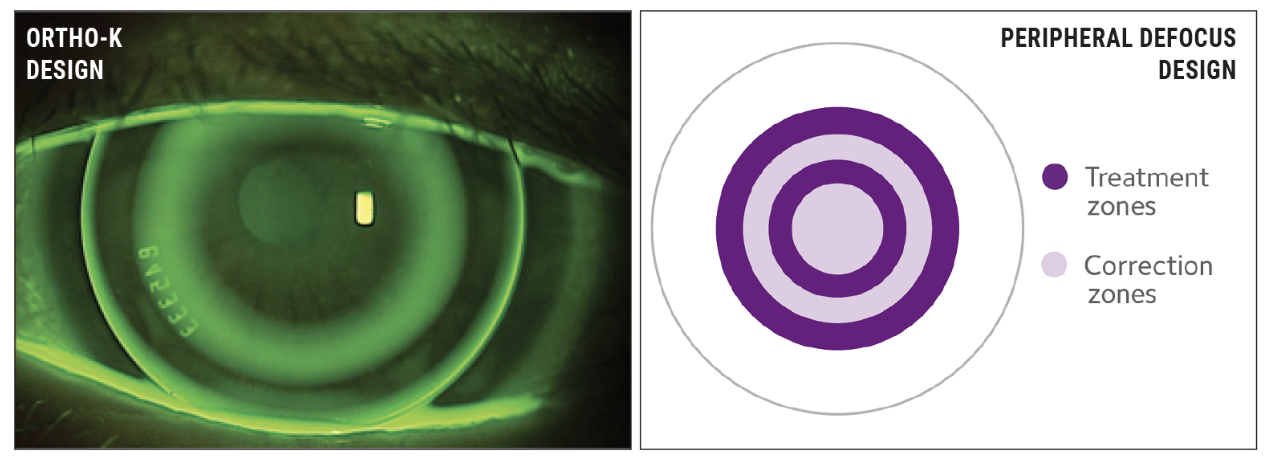OrthoK for Myopia Management
What is Ortho-K?
Orthokeratology, often abbreviated as Ortho-K or OK, is a non-surgical method for managing myopia (nearsightedness). It involves the use of specially designed rigid gas permeable contact lenses that are worn overnight. These lenses reshape the cornea temporarily, providing clear vision without the need for glasses or contact lenses during the day.
How does Ortho-K work for myopia management?
Lens Design: Ortho-K lenses are designed to exert gentle pressure on the cornea, causing a controlled reshaping of its curvature. This reshaping aims to reduce or eliminate myopia by altering the way light is focused on the retina. The lenses have been shown to thin the epithelium centrally from 50-55 to 40-45 and thicken the epithelium under the reverse curve. Changes in peripheral refraction have been thought to result in myopia control through “relative peripheral myopic defocus.”
Nighttime Wear: Ortho-K lenses are worn while sleeping, typically overnight. The lenses are removed upon waking in the morning, and the reshaped cornea allows for clear vision throughout the day.
Temporary Effect: The corneal reshaping effect is temporary, and the cornea gradually returns to its original shape if lens wear is discontinued. Therefore, Ortho-K lenses need to be worn regularly to maintain the desired refractive changes.
Orthokeratology is considered a form of myopia control because it can slow down the progression of myopia in some individuals, particularly in children and teenagers. The exact mechanism behind the myopia control effect is not fully understood, but it is believed that the reshaping of the cornea may alter the peripheral defocus and influence the growth of the eye.
What are the benefits of Ortho-K for myopia management?
Reduced Progression of Myopia: Studies suggest that Ortho-K may help slow down the progression of myopia in children and adolescents.
Freedom from Daytime Correction: Individuals using Ortho-K lenses can enjoy clear vision during the day without the need for glasses or daytime contact lenses.
Non-Surgical: Ortho-K is a non-surgical alternative to procedures like LASIK.
It's important to note that Ortho-K is not suitable for everyone, and individual responses may vary. Regular eye examinations and consultations with an eye care professional are essential for proper fitting, monitoring, and maintenance of Ortho-K lenses. If you are interested in Ortho-K for myopia management, consult with an eye care professional who can assess your eligibility and provide guidance based on your specific needs and eye health.
“There is much we do not know about myopia and myopia progression. But we know enough to know that we can not do nothing”
How do you quantify myopia control?
CARE - Cumulative Absolute Reduction in Axial Elongation
Measurement in changes in axial length expressed as an absolute quantity (mm of AL), not relative
Axial length is more accurate and associated with pathology
Better representation of treatment effect for an individual patient
What Are Other Options for Myopia Control?
Ortho-K
Soft Multifocals (MiSight)
Atropine
Does Lower Amount of Myopia Benefit Your Patient?
Less visual disability when uncorrected
Better options for, and outcomes from, surgical myopia correction
Reduced risk of vision impairment associated with higher levels of myopia
Who is an ideal candidate for Ortho-K?
Myopia (-1.00D to -5.00D for VST, -1.00D to -6.00D for CRT)
Astigmatism (Up to -1.75 WTR and up to -1.50 ATR)
Progressing myopes
Motivated to avoid glasses
No age restrictions.
However, orthok is more effective at an earlier age (~8 years old.)
Expressed interest in myopia management
““...the sooner a myopia control strategy is implemented, the greater potential there is to make clinically significant differences to a myopic child’s refractive and long term eye health outcomes” ”
What information is needed for an Ortho-K lens design?
Baseline K’s and corneal astigmatism
Baseline refraction
Pupil size
Anterior chamber depth
It’s important to note that Ortho-K is not one size fits all. The same lens design can produce very different responses in each individual patient.
““......Individual variation in myopic progression, cause by many different factors such as age of onset, heredity, parental myopia, near work, time spent outdoors, and others” ”
How Often is an Ortho-K Patient Seen in Office?
Follow-ups are performed every 6 months
The following should be evaluated at each follow up:
Unaided VA
Topography
Slit lamp evaluation
IOP
Internal evaluation
Cycloplegic refraction
Refraction
AXIAL LENGTH
Discuss of hours of wear
Review of wear schedule, care, disinfection, lubricatinf drops
Inspection of lenses and case
Set up next appointment
When Is It Appropriate to Stop Ortho-K?
No need to stop if not indicated
If the patient cannot maintain regular wear
If the patient wants to wear soft contact lenses and/or glasses
If the patient is interested in LASIK
If the patient is interested in only myopia management then stopping around 21/22 is indicated.
Learn more about Orthokeratology
The information in this article is courtesy of Dr. Michael Lipson’s Course “The Role of Orthokeratology in Myopia Management.” Follow the link to watch his course and earn one hour of On Demand CE.



